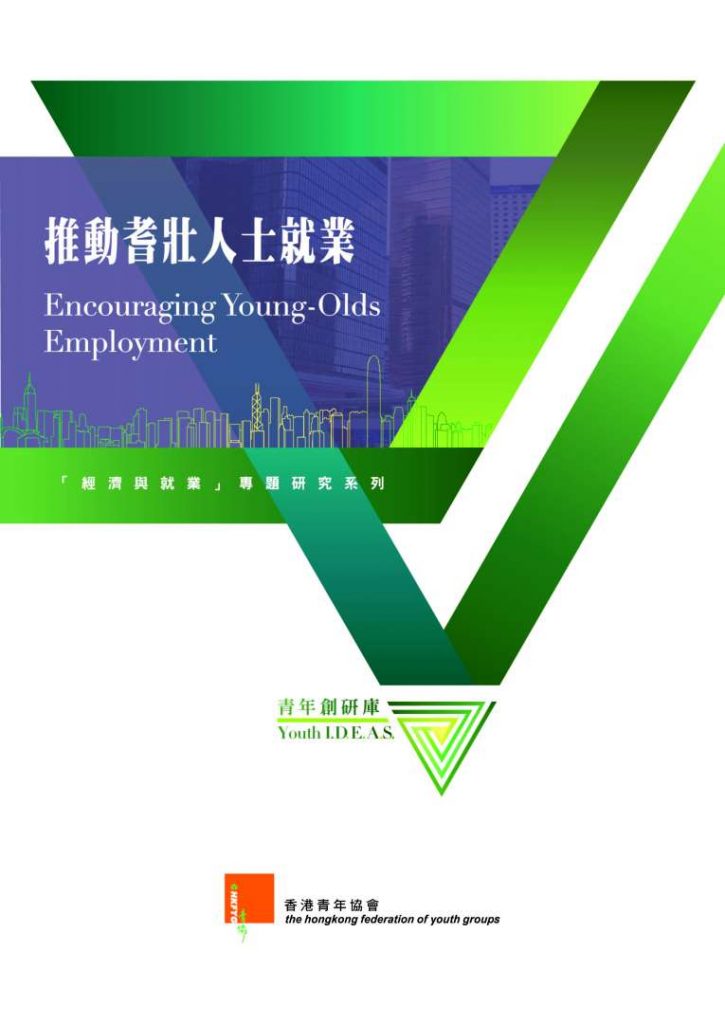Encouraging Young-Olds Employment
Youth I.D.E.A.S. 31
Employment and Economic Development
Encouraging Young-Olds Employment
26 June, 2018
 The world is currently facing the problems of an aging population and a shrinking labour force. The International Labour Organization (ILO) points out that two billion people will be aged 60 or over by 2050. This means that there will be a change in labour supply, and many industries will have to attract more workers from the older sections of the population. The ILO proposes that policies should be formulated to provide post-retirement opportunities to retrain older workers so they can perform other jobs in the long run in order to solve the problems of a shrinking labour force[1].
The world is currently facing the problems of an aging population and a shrinking labour force. The International Labour Organization (ILO) points out that two billion people will be aged 60 or over by 2050. This means that there will be a change in labour supply, and many industries will have to attract more workers from the older sections of the population. The ILO proposes that policies should be formulated to provide post-retirement opportunities to retrain older workers so they can perform other jobs in the long run in order to solve the problems of a shrinking labour force[1].
The trend of population aging is becoming increasingly salient. According to the Census and Statistics Department[2], there were a total of 1,163,153 persons aged 65 and above in 2016, representing 15.9% of the total population of Hong Kong. Meanwhile, the overall labour force participation rate will decrease gradually from 59.2% in 2016 to 49.6% in 2066[3]. These figures reflect the fact that the labour force is gradually shrinking due to an aging population, a trend which might hinder the overall economic development of Hong Kong.
In addition, the elderly dependency ratio doubled in 30 years: increasing from 109[4] in 1986 to 218 in 2016. Therefore, society is starting to face the financial strains of supporting the elderly. Since a comprehensive pension system is yet to be set up in Hong Kong, most people rely on personal savings or family members for their financial needs after retirement, which may economically burden the younger generation.
However, many people nowadays are still able to work even after reaching the age of retirement due to social and medical advancements. According to the Census and Statistics Department[5], there are 1,734,858 persons aged between 55 and 74, of which 679,260 are retired, accounting for 39.2% of this age group. If this group of young-olds was healthy and willing to continue to serve in the workplace, not only would it bring in an income for themselves and their families, but it would also reduce the economic burden on the younger generation as well as improve the problems of a shrinking labour force.
Indeed, other parts of the world are encountering the same challenges of trying to re-integrate the young-olds into the workforce. One significant issue concerns the creation of an appropriate environment to encourage healthy young-olds with intentions of working to re-join the workforce. This study examines the problem by looking at foreign policy experiences, the work intentions of young-olds and the obstacles they face in finding suitable work, as well as the attitudes of young people to young-old employment. It is hoped that concrete recommendations can be made to encourage the employment of retired young-olds aged 55-74 to alleviate the problems of a shrinking workforce.
This study uses data collected by three methods during the period from April to May 2018: an on-site survey of 520 young people aged 18-34, case interviews with 20 young-olds aged 55-74, and interviews with six experts and scholars.
Discussion
- Because of population aging and a decline in the birth rate, manpower will be in short supply. The issue of overall financial support for the elderly has put economic pressure on the younger generation. Although figures show that the labour force participation rate of the young-olds is gradually increasing, the actual rate is still low when compared to that of other Asian countries.
- The young respondents in general support the employment of young-olds after they retire. They are not worried about the effects of this on young people’s career prospects. Instead, they agree that it will alleviate the economic burden on young people. In addition, the experts and scholars interviewed think that the influence of young-old employment on younger people would depend on the employment practices of individual organizations. Many young-olds are willing to stay in minor positions because their aim is to continue to be socially engaged. It would not obstruct the development of the younger generation.
- The major limitations and problems of young-olds when job seeking:
3.1 Many young-olds hope to find flexible forms of work such as part-time, short-term or freelance work. But the number of flexible posts suitable for young-olds is limited.
3.2 The educational credentials and computing knowledge of young-olds may not meet the requirements of the labour market. But their characters, work attitudes and accumulated experiences can help to solve the problems that arise in the workplace.
3.3 The complicated worker insurance procedures for older workers and the higher premiums discourage employers from hiring them.
Recommendation
- The government should provide flexible job openings for retired people.
- Introduce an employment scheme to help young-olds with career planning, training and job market information.
- Help industries that have a short supply of labour to re-design their jobs and to adapt full-time jobs into flexible jobs.
- Provide tax breaks to encourage enterprises to hire at least 3% of their employees from the young-old demographic.
- The Labour Department should set up a Code of Practice on Human Resource Management and provide appropriate training for the management of young-olds who take up flexible jobs.
- The government should take the initiative to communicate with the insurance sector to encourage the industry to set up standards for worker insurance premiums for employees up to the age of 75.
[1] International Labor Organization. (2011). “A changing world: Adapting to an aging population in the workplace” in World of Work, 73, December 2011. Retrieved from http://www.ilo.org/global/publications/world-of-work-magazine/articles/WCMS_170533/lang–en/index.htm
[2] Census and Statistics Department. (2018). 2016 Population by-census thematic report: Older persons. Hong Kong: Census and Statistics Department.
[3] Census and Statistics Department. (2017). Hong Kong labour force projections for 2017 to 2066. Hong Kong: Census and Statistics Department.
[4] The number of persons aged 65 and over per 1,000 persons aged between 15 and 64.
[5] Census and Statistics Department. (2018). “2016 Population By-census”. Retrieved from https://www.bycensus2016.gov.hk/tc/bc-own_tbl.html




